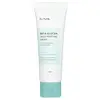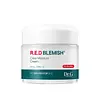What's inside
What's inside
 Key Ingredients
Key Ingredients

 Benefits
Benefits

 Concerns
Concerns

 Ingredients Side-by-side
Ingredients Side-by-side

Water
Skin ConditioningButylene Glycol
HumectantGlycerin
HumectantMethyl Trimethicone
Skin ConditioningCentella Asiatica Extract
CleansingBeta-Glucan
Skin ConditioningCetearyl Alcohol
Emollient1,2-Hexanediol
Skin ConditioningNiacinamide
SmoothingHydrogenated Polyisobutene
EmollientIsononyl Isononanoate
EmollientCetearyl Glucoside
EmulsifyingGlyceryl Stearate
EmollientSorbitan Stearate
EmulsifyingCetearyl Olivate
Sorbitan Olivate
EmulsifyingAcrylates/C10-30 Alkyl Acrylate Crosspolymer
Emulsion StabilisingBetaine
HumectantAllantoin
Skin ConditioningAdenosine
Skin ConditioningDipotassium Glycyrrhizate
HumectantGlucose
HumectantSodium Hyaluronate
HumectantArginine
MaskingPrunus Salicina Fruit Extract
AntioxidantPunica Granatum Fruit Extract
AntioxidantRubus Idaeus Fruit Extract
AstringentFragaria Vesca Fruit Extract
AstringentPrunus Persica Fruit Extract
AbrasiveWater, Butylene Glycol, Glycerin, Methyl Trimethicone, Centella Asiatica Extract, Beta-Glucan, Cetearyl Alcohol, 1,2-Hexanediol, Niacinamide, Hydrogenated Polyisobutene, Isononyl Isononanoate, Cetearyl Glucoside, Glyceryl Stearate, Sorbitan Stearate, Cetearyl Olivate, Sorbitan Olivate, Acrylates/C10-30 Alkyl Acrylate Crosspolymer, Betaine, Allantoin, Adenosine, Dipotassium Glycyrrhizate, Glucose, Sodium Hyaluronate, Arginine, Prunus Salicina Fruit Extract, Punica Granatum Fruit Extract, Rubus Idaeus Fruit Extract, Fragaria Vesca Fruit Extract, Prunus Persica Fruit Extract
Water
Skin ConditioningGlycerin
Humectant2,3-Butanediol
HumectantHydrogenated Poly(C6-14 Olefin)
EmollientCentella Asiatica Extract
CleansingNiacinamide
SmoothingBetaine
HumectantVinyldimethicone
Cyclohexasiloxane
Emollient1,2-Hexanediol
Skin ConditioningCetyl Ethylhexanoate
EmollientHydrogenated Polydecene
EmollientJojoba Esters
EmollientHydrogenated Lecithin
EmulsifyingSodium Hyaluronate
HumectantMacadamia Ternifolia Seed Oil
EmollientHydrogenated Rapeseed Oil
EmollientCaprylic/Capric Triglyceride
MaskingHydroxyethyl Acrylate/Sodium Acryloyldimethyl Taurate Copolymer
Emulsion StabilisingHexyldecyl Laurate
EmollientHexyldecanol
EmollientSilica
AbrasiveAmmonium Acryloyldimethyltaurate/Vp Copolymer
C14-22 Alcohols
Emulsion StabilisingArachidyl Alcohol
EmollientPalmitic Acid
EmollientC12-20 Alkyl Glucoside
EmulsifyingGlyceryl Stearate
EmollientDipropylene Glycol
HumectantAllantoin
Skin ConditioningStearic Acid
CleansingBehenyl Alcohol
EmollientArachidyl Glucoside
EmulsifyingCarbomer
Emulsion StabilisingSodium Stearoyl Glutamate
CleansingSorbitan Isostearate
EmulsifyingDisodium EDTA
Panthenol
Skin ConditioningSucrose Distearate
EmollientButylene Glycol
HumectantGlucose
HumectantMyristic Acid
CleansingCeramide NP
Skin ConditioningMadecassoside
AntioxidantAsiaticoside
AntioxidantMadecassic Acid
Skin ConditioningAsiatic Acid
Skin ConditioningPhytosphingosine
Skin ConditioningHydroxyacetophenone
AntioxidantEthylhexylglycerin
Skin ConditioningWater, Glycerin, 2,3-Butanediol, Hydrogenated Poly(C6-14 Olefin), Centella Asiatica Extract, Niacinamide, Betaine, Vinyldimethicone, Cyclohexasiloxane, 1,2-Hexanediol, Cetyl Ethylhexanoate, Hydrogenated Polydecene, Jojoba Esters, Hydrogenated Lecithin, Sodium Hyaluronate, Macadamia Ternifolia Seed Oil, Hydrogenated Rapeseed Oil, Caprylic/Capric Triglyceride, Hydroxyethyl Acrylate/Sodium Acryloyldimethyl Taurate Copolymer, Hexyldecyl Laurate, Hexyldecanol, Silica, Ammonium Acryloyldimethyltaurate/Vp Copolymer, C14-22 Alcohols, Arachidyl Alcohol, Palmitic Acid, C12-20 Alkyl Glucoside, Glyceryl Stearate, Dipropylene Glycol, Allantoin, Stearic Acid, Behenyl Alcohol, Arachidyl Glucoside, Carbomer, Sodium Stearoyl Glutamate, Sorbitan Isostearate, Disodium EDTA, Panthenol, Sucrose Distearate, Butylene Glycol, Glucose, Myristic Acid, Ceramide NP, Madecassoside, Asiaticoside, Madecassic Acid, Asiatic Acid, Phytosphingosine, Hydroxyacetophenone, Ethylhexylglycerin
 Reviews
Reviews

Ingredients Explained
These ingredients are found in both products.
Ingredients higher up in an ingredient list are typically present in a larger amount.
1,2-Hexanediol is a synthetic liquid and another multi-functional powerhouse.
It is a:
- Humectant, drawing moisture into the skin
- Emollient, helping to soften skin
- Solvent, dispersing and stabilizing formulas
- Preservative booster, enhancing the antimicrobial activity of other preservatives
Allantoin is a soothing ingredient known for its protective and moisturizingg properties. Because of this, it is often added to products with strong active ingredients.
Studies show higher concentrations of this ingredient can promote wound healing.
Though it can be derived from the comfrey plant, allantoin is produced synthetically for cosmetic products to ensure purity.
Learn more about AllantoinBetaine is a common humectant (a substance that promotes retention of moisture). It's known to be gentle on the skin and can help balance hydration.
This ingredient is best for improving hydration and soothing irritated skin. Studies also show it helps even out skin tone.
Fun fact: Betaine is naturally created in the skin and body. The kind found within cosmetic products can be either plant-derived or synthetic.
Another name for betaine is trimethylglycine.
Learn more about BetaineButylene Glycol (or BG) is used within cosmetic products for a few different reasons:
Overall, Butylene Glycol is a safe and well-rounded ingredient that works well with other ingredients.
Though this ingredient works well with most skin types, some people with sensitive skin may experience a reaction such as allergic rashes, closed comedones, or itchiness.
Learn more about Butylene GlycolCentella Asiatica Extract (Centella) is derived from an herb native to Southeast Asia. It is famous for its anti-inflammatory and soothing properties.
Centella is rich in antioxidants and amino acids, such as Madecassic Acid and Asiaticoside.
Studies show the compounds in centella help with:
The combination of all these properties makes centella effective at soothing, hydrating, and protecting the skin.
Other great components of centella include Vitamin A, vitamin C, several B vitamins, and Asiatic Acid.
Fun fact: Centella has been used as a medicine and in food for many centuries. As a medicine, it is used to treat burns, scratches, and wounds.
Learn more about Centella Asiatica ExtractGlucose is a simple sugar and is the most important source of energy in all organisms.
In skincare, glucose is used to hydrate the skin. It also acts as a prebiotic for our natural biome.
Glucose is hydrating due to its humectant property. As a humectant, glucose draws moisture from the air and from deeper levels in the skin.
Our skin contains many sugars that act as prebiotics and help strengthen our natural microbiome. Having a healthy microbiome helps protect our skin from harmful bacteria and other contaminants.
Studies show glucose may help with fading discoloration and pigmentation. This is because our skin metabolizes glucose into lactic acid. Lactic acid is an AHA that helps exfoliate the top layer of skin.
Learn more about GlucoseGlycerin is already naturally found in your skin. It helps moisturize and protect your skin.
A study from 2016 found glycerin to be more effective as a humectant than AHAs and hyaluronic acid.
As a humectant, it helps the skin stay hydrated by pulling moisture to your skin. The low molecular weight of glycerin allows it to pull moisture into the deeper layers of your skin.
Hydrated skin improves your skin barrier; Your skin barrier helps protect against irritants and bacteria.
Glycerin has also been found to have antimicrobial and antiviral properties. Due to these properties, glycerin is often used in wound and burn treatments.
In cosmetics, glycerin is usually derived from plants such as soybean or palm. However, it can also be sourced from animals, such as tallow or animal fat.
This ingredient is organic, colorless, odorless, and non-toxic.
Glycerin is the name for this ingredient in American English. British English uses Glycerol/Glycerine.
Learn more about GlycerinGlyceryl Stearate is a mix of glycerin and stearic acid.
It is used to stabilize the mixing of water and oil ingredients. By preventing these ingredients from separating, it can help elongate shelf life. It can also help thicken the product's texture.
As an emollient, it helps soften skin and supports barrier-replenishing ingredients.
In cosmetics, Glyceryl Stearate is often made from vegetable oils or synthetically produced.
This ingredient may not be fungal-acne safe
Fun fact: The human body also creates Glyceryl Stearate naturally.
Learn more about Glyceryl StearateNiacinamide is a multitasking form of vitamin B3 that strengthens the skin barrier, reduces pores and dark spots, regulates oil, and improves signs of aging.
And the best part? It's gentle and well-tolerated by most skin types, including sensitive and reactive skin.
You might have heard of "niacin flush", or the reddening of skin that causes itchiness. Niacinamide has not been found to cause this.
In very rare cases, some individuals may not be able to tolerate niacinamide at all or experience an allergic reaction to it.
If you are experiencing flaking, irritation, and dryness with this ingredient, be sure to double check all your products as this ingredient can be found in all categories of skincare.
When incorporating niacinamide into your routine, look out for concentration amounts. Typically, 5% niacinamide provides benefits such as fading dark spots. However, if you have sensitive skin, it is better to begin with a smaller concentration.
When you apply niacinamide to your skin, your body converts it into nicotinamide adenine dinucleotide (NAD). NAD is an essential coenzyme that is already found in your cells as "fuel" and powers countless biological processes.
In your skin, NAD helps repair cell damage, produce new healthy cells, support collagen production, strengthen the skin barrier, and fight environmental stressors (like UV and pollution).
Our natural NAD levels start to decline with age, leading to slower skin repair, visible aging, and a weaker skin barrier. By providing your skin niacinamide, you're recharging your skin's NAD levels. This leads to stronger, healthier, and younger looking skin.
Another name for vitamin B3 is nicotinamide. This vitamin is water-soluble and our bodies don't store it. We obtain Vitamin B3 from either food or skincare. Meat, fish, wheat, yeast, and leafy greens contain vitamin B3.
The type of niacinamide used in skincare is synthetically created.
Learn more about NiacinamideSodium Hyaluronate is hyaluronic acid's salt form. It is commonly derived from the sodium salt of hyaluronic acid.
Like hyaluronic acid, it is great at holding water and acts as a humectant. This makes it a great skin hydrating ingredient.
Sodium Hyaluronate is naturally occurring in our bodies and is mostly found in eye fluid and joints.
These are some other common types of Hyaluronic Acid:
Learn more about Sodium HyaluronateWater. It's the most common cosmetic ingredient of all. You'll usually see it at the top of ingredient lists, meaning that it makes up the largest part of the product.
So why is it so popular? Water most often acts as a solvent - this means that it helps dissolve other ingredients into the formulation.
You'll also recognize water as that liquid we all need to stay alive. If you see this, drink a glass of water. Stay hydrated!
Learn more about Water